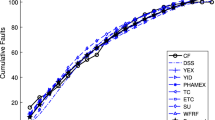Abstract
In today’s environment of global competition where each company is trying to prove itself better than its competitors the software developers have to come up with multiple releases in order to survive in the market. Each release offers some innovative performance enhancement or some new functionality that distinguishing itself from the past release. But enhancing the product and upcoming with successive releases puts a constant pressure on even the best organized engineering organizations. The reason being, up-grading a software application is a complex process. Upgrading a software introduces the risk that the new release will contain a bug, causing the program to fail. Therefore, to capture the effect of faults generated in the software with multiple releases, we have developed a multi release software reliability model in this paper. The model uniquely takes into account the faults of the current release and the remaining faults of just previous release. The multi release software reliability growth model treats the fault removal rate as a function of testing resources consumed. In addition, the model also incorporates the severity of faults and considers that hard faults are removed with different rate than the rate required to remove simple faults. The model developed is validated on real data set with software which has been released in the market with new features four times.






Similar content being viewed by others
References
Bittanti S, Bolzern P, Pedrotti E, Scattolini R (1988) A flexible modelling approach for software reliability growth. In: Goos G, Harmanis J (eds) Software reliability modelling and identification. Springer, Berlin, pp.101–140
Goel AL, Okumoto K (1979) Time dependent error detection rate model for software reliability and other performance measures. IEEE Trans Reliab R-28:206–211
Huang CY, Kuo SK, Lyu MR (2007) An assessment of testing-effort dependent software reliability growth models. IEEE Trans Reliab 56:198–211
Kapur PK, Garg RB (1992) A software reliability growth model for an error removal phenomenon. Softw Eng J 7:291–294
Kapur PK, Garg RB, Kumar S (1999) Contributions to hardware and software reliability. World Scientific, Singapore
Kapur PK, Goswami DN, Bardhan A, Singh O (2008) Flexible software reliability growth model with testing effort dependent learning process. Appl Math Model 32:1298–1307
Kapur PK, Aggarwal A, Kapoor K, Kaur G (2009) Optimal testing resource allocation for modular software considering cost, testing effort and reliability using genetic algorithm. Int J Reliab Qual Saf Eng 16(6):495–508
Kapur PK, Tandon A, Kaur G (2010) Multi Up- gradation software reliability Model. In: 2nd International conference on reliability, safety&hazard (ICRESH-2010) pp. 468–474
Kapur PK, Singh Ompal, Singh Jagvinder, Garmabaki AS (2010b) Multi Up-Gradation Software Reliability Growth Model with Imperfect Debugging. Int J Syst Assur Eng Manag 1(4):299–306
Kapur PK, Aggarwal AG, Kaur G (2010) Testing-resource dependent flexible reliability growth model for software with multiple releases. accepted for publication in the proceedings of International conference on development and applications of statistics in emerging areas of science and technology (ICDASEAST),2010 Jammu
Kapur PK, Pham H, Jha PC, Gupta A (2011) Software reliability assessment with OR applications. Springer, London
Lyu MR (1996) Handbook of software reliability engineering. IEEE Computer Society Press, Los Alamitos
Musa JD, Iannini A, Okumoto K (1990) Software reliability: measurement, prediction, applications, professional edition., Software engineering seriesMcGraw–Hill, New York
Ohba M (1984) Software reliability analysis models. IBM J Res Dev 28(4):428–443
Ohba M and Yamada S (1984) S-shaped software reliability growth model In: Proceedings of the 4th international conference on reliability and maintainability, pp. 430–436
Pham H (2000) Software reliability. Springer-Verlag, Singapore
Williams, Martyn (2005-11-01). “Software glitch halts Tokyo Stock Exchange”. InfoWorld. http://www.infoworld.com/article/05/11/01/HNtokyoexchange_1.html?APPLICATION%20PERFORMANCE%20MANAGEMENT. Retrieved 2008-07-30. Associated Press (2006-04-20). “Official: Software glitch, not bomb, shut airport”. MSNBC. http://www.msnbc.msn.com/id/12411853/. accessed 30 july 2008
Wood A (1996) Predicting software reliability. IEEE Comput 11:69–77
Yamada S, Ohba M, Osaki S (1983) S-shaped software reliability growth modelling for software error detection. IEEE Trans Reliab R-32(5):475–484
Yamada S, Ohtera H, Narihisa H (1986) Software reliability growth models with testing-effort. IEEE Trans Reliab 35(1):19–23
Author information
Authors and Affiliations
Corresponding author
Rights and permissions
About this article
Cite this article
Singh, O., Aggrawal, D., Anand, A. et al. Fault severity based multi-release SRGM with testing resources. Int J Syst Assur Eng Manag 6, 36–43 (2015). https://doi.org/10.1007/s13198-014-0241-6
Received:
Published:
Issue Date:
DOI: https://doi.org/10.1007/s13198-014-0241-6




